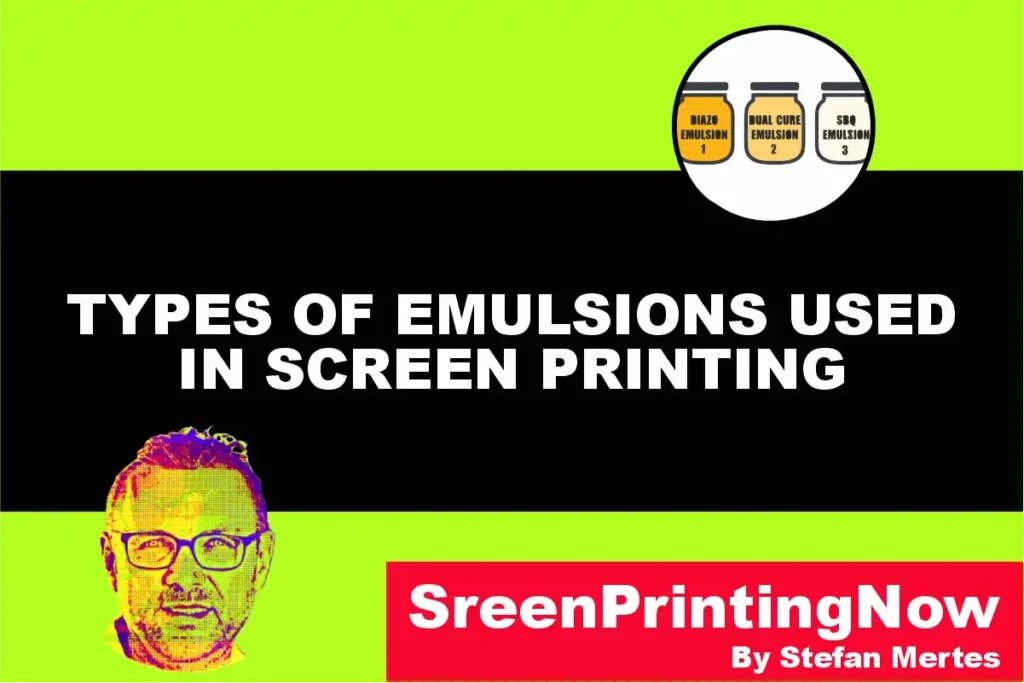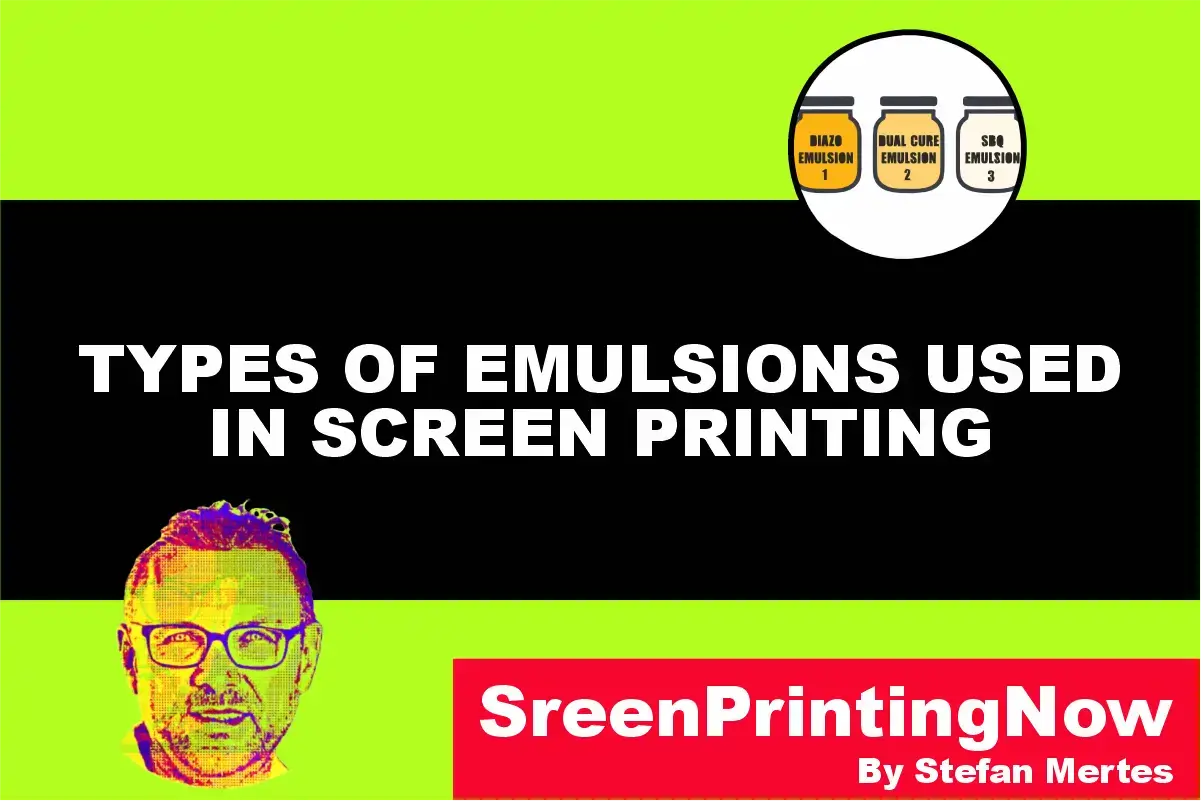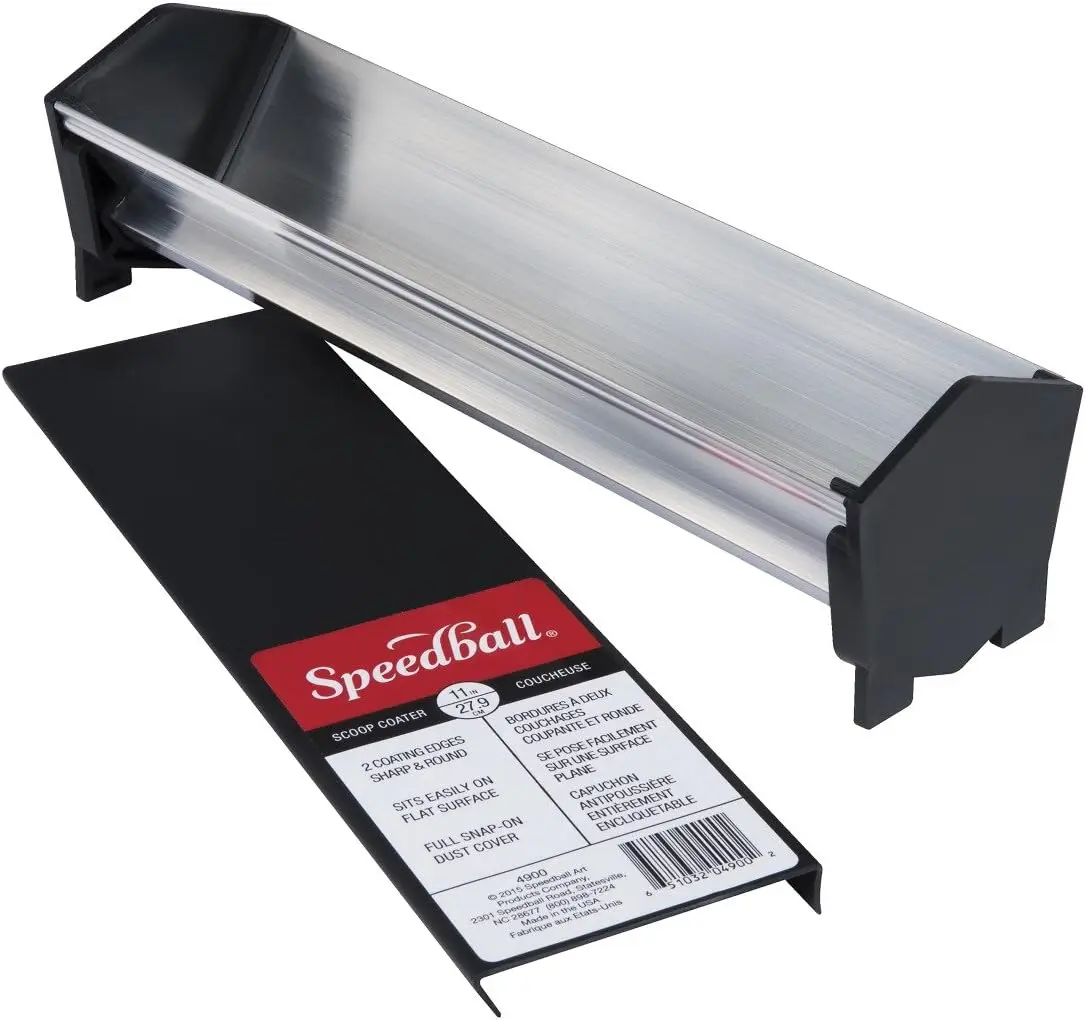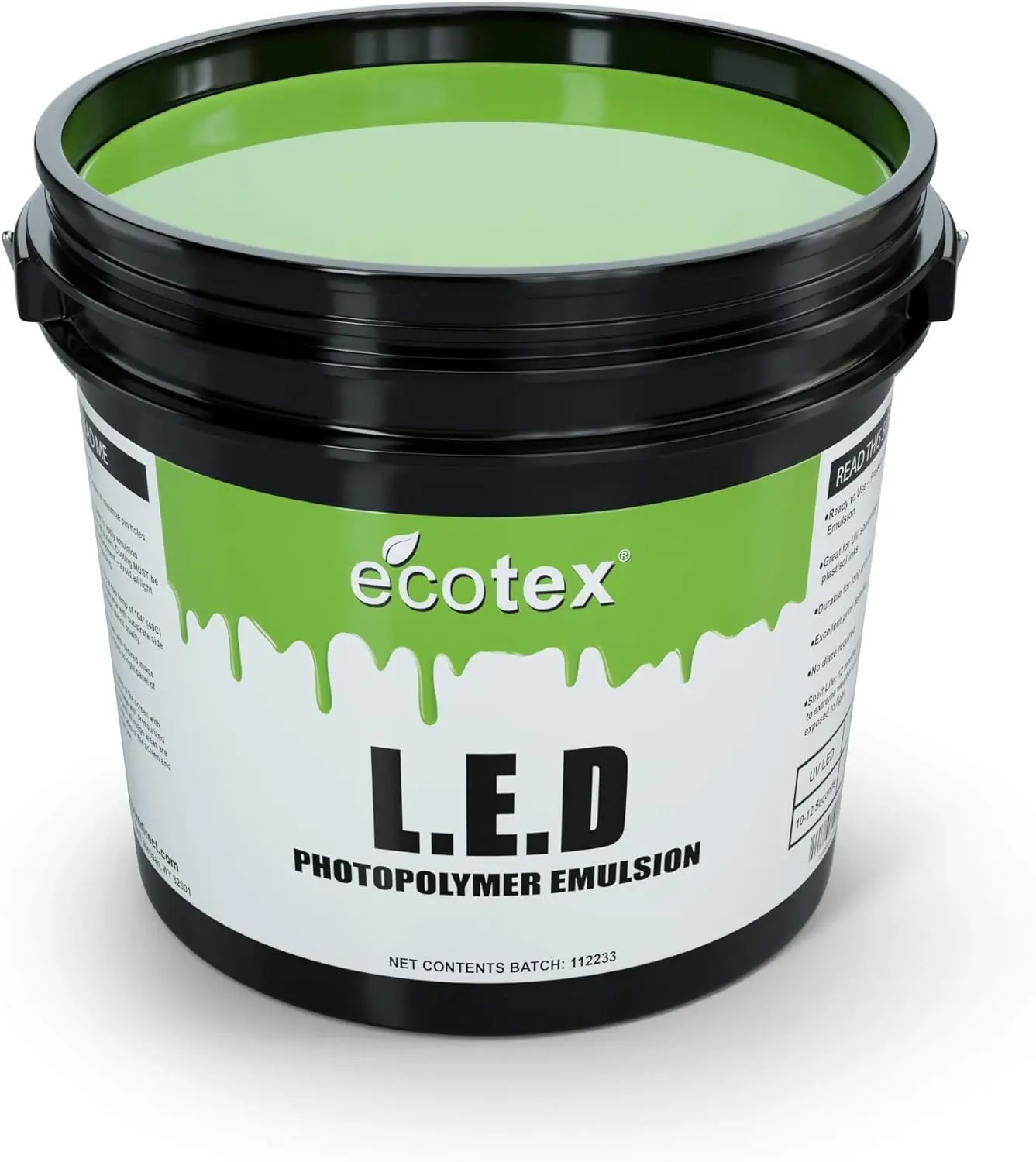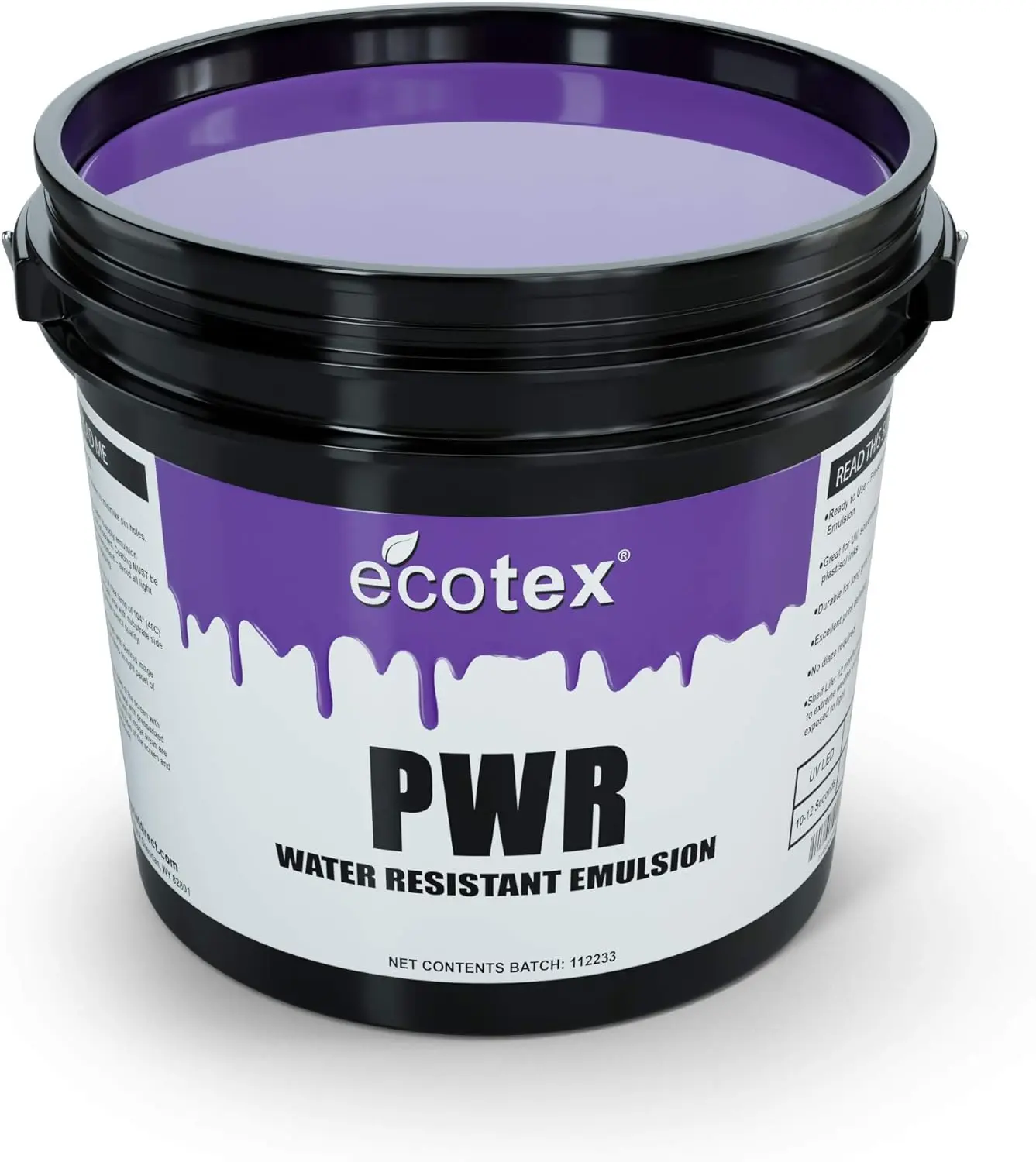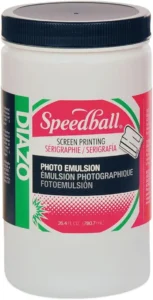Screen printing emulsions are applied directly to the cleaned and degreased screen through a scoop coater. After drying, it is light-sensitive and can be exposed to ultraviolet light. This is how you transfer your design (film) onto the screen.
The area where the light hits the emulsion becomes waterproof. The area where the light does not hit the emulsion, covered by the film, remains water soluble and can be washed out. You have now transferred your positive film to the screen.
Three Types of Screen Printing Emulsions

- Diazo
- Dual-Cure
- SBQ Photopolymer
Diazo Emulsion
Diaso emulsions consist of a two-component system containing a sensitiser mixed with a non-sensitiser. They are low cost, lightweight diazo emulsions that are now being replaced by dual cure and SBQ emulsions. They have a shelf life of 30-45 days after mixing.
Dual Cure Emulsions
Dual cure emulsions are also a two-part system, but differ as the sensitiser is already mixed into a base, allowing for fast exposure, durability, sharp edge definition and long shelf life. Dual cure offers a wider exposure latitude to capture more of the image more easily.
Washing and development of a Dual Cure emulsion is slightly easier than with a pure photopolymer emulsion. Dual Cure emulsions retain their properties even when slightly underexposed or overexposed. They are more expensive than Diaso emulsions, but less expensive than SBQ emulsions.
SBQ Emulsions for Screen Printing
SBQ emulsions are described as pure photopolymer emulsions and have the fastest exposure times. They do not require mixing and have a shelf life of one year.
This premium product is more expensive than diazo and dual cure emulsions. Excellent mesh bridging. Stencil surface area (Rz) is reduced compared to the diazo emulsion as it contains less water.
How to use the Emulsion for Screen Printing
- Ensure that the screens are degreased and thoroughly dried before coating.
- Screen tension should be at least 20 N/cn for best results.
- Coat the contact side of the screen first. The contact side is the side that will be in contact with the garment during printing. The last coat should be applied to the inside (squeegee side) of the screen.
- Use the blunt edge of the coater for maximum EOM or select the sharp edge for a thin screen.
- Screens should be dried horizontally with the contact side down.
- Your coating room should be free of dust!
- Do not use a fan to blow air directly onto the coated screen to dry it, as this will only push dust onto the screen, which can cause pinholes later.
- When dry, apply another top coat to reduce the RZ.
- Do not use excessive heat when drying the coated stencils at 30° to 40° C (86° to 104° F) as this will cause premature activation of the sensitiser.
- After coating and drying, store the screens in a room or cabinet that is protected from light.
- Store your coated and dry screen at 30% to max. 50% relative humidity.
Important to know, what ink you are gone be printing
You need to see, what ink you are printing, as mostly, for Plastisol inks, or water-based printing inks the emulsion is different. Like most water-based inks, you would need a hardener. But please check this out with your supplier.
Emulsion Over Mesh (EOM )
Emulsion over mesh (EOM) = total stencil thickness minus mesh thickness, and Stencil Surface (Rz) indicates the smoothness of the surface.

EOM Emulsion over Mesh

Stencil Surface (Rz)
Scoop Coater
All of these emulsions are applied to the screen using a scoop or automatic screen coater. The sharp edge applies a thin layer of emulsion. This is ideal for making stencils with fine detail, halftone printing and other applications that require a thin layer of ink on the substrate. The blunt edge applies a thicker layer for optimum EOM results.
Capillary Film
Sometimes, you will use a capillary film. The advantages of capillary films include superior mesh bridging, no pinholes, excellent Rz value. Thick capillary films are the secret to success when executing high-density (HD), tall puff, and other types of special effects (SFX) prints. Capillary films range in thickness from 10-50 microns for standard printing and 100-400 microns for HD and SFX printing.
Questions & Answer
What are the different types of emulsions used in screen printing?
The different types of emulsions used in screen printing are Diazo, Dual-Cure, SBQ Photopolymer. Each type of emulsion has its own benefits and features and should be selected based on the type of ink being used and the desired printing results.
What are the benefits of using dual cure emulsions?
Benefits of using Dual Cure Emulsions include a wider exposure latitude to capture more of the image easily, faster exposure times, durability, sharp edge definition, long shelf life, and easier washing and development compared to photopolymer emulsions. Additionally, Dual Cure Emulsions retain their properties even when slightly underexposed screen printing or overexposed, making them a popular choice for screen printing.
What is the shelf life of a diazo emulsion?
Diazo emulsions have a shelf life of 30-45 days after mixing and must be stored in a light-protected room or cabinet after coating and drying. Dual cure emulsions have a longer shelf life and are slightly easier to wash and develop than photopolymer emulsions. SBQ emulsions have the longest shelf life of one year and are the most expensive type of emulsion. All types of emulsions are applied using a scoop coater or automatic screen coater and require different thicknesses of capillary film depending on the type of printing.

